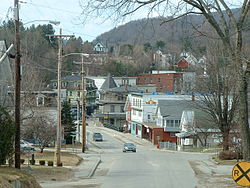Hardwick, Vermont
| Hardwick, Vermont | |
|---|---|
| Town | |

North Main Street
|
|
 Hardwick, Vermont |
|
| Location in the United States | |
| Coordinates: 44°31′5″N 72°20′59″W / 44.51806°N 72.34972°WCoordinates: 44°31′5″N 72°20′59″W / 44.51806°N 72.34972°W | |
| Country | United States |
| State | Vermont |
| County | Caledonia |
| Chartered | 1781 |
| Area | |
| • Total | 39.0 sq mi (101.1 km2) |
| • Land | 38.6 sq mi (100.0 km2) |
| • Water | 0.4 sq mi (1.0 km2) |
| Elevation | 1,339 ft (408 m) |
| Population (2010) | |
| • Total | 3,010 |
| • Density | 78/sq mi (30.1/km2) |
| Time zone | Eastern (EST) (UTC-5) |
| • Summer (DST) | EDT (UTC-4) |
| ZIP codes | 05843, 05836 (in East Hardwick) |
| Area code(s) | 802 Exchange: 472 |
| FIPS code | 50-31825 |
| GNIS feature ID | 1462115 |
| Website | hardwickvt |
Hardwick is a town in Caledonia County, Vermont, United States. The population was 3,010 at the 2010 census. It contains the incorporated village of Hardwick and the unincorporated villages of East Hardwick and Mackville. The town is a commercial center for the region's farming population.
The main settlement of Hardwick in the center of the town is a census-designated place (CDP), with a population of 1,345 at the 2010 census.
During the Revolutionary War, General George Washington ordered construction of the Bayley-Hazen Military Road to provide access into the interior of Vermont. It would prompt the development and settlement of Hardwick and East Hardwick.
The town was granted by the Vermont General Assembly on November 7, 1780, then chartered on August 19, 1781, to Danforth Keyes and 66 others, some of whom were from Hardwick, Massachusetts. Permanent settlement began in 1793 when several families named Norris arrived from New Hampshire. By 1859, when the population reached 1,402, the town had several sawmills and gristmills on the Lamoille River. There were also two tanneries. Over the years, other industries would include a woolen mill, tinware shop, and carriage factory.
The predominant business following the Civil War was granite quarrying, especially after the Portland & Ogdensburg Railway opened service through the town and facilitated shipment of stone. While most of the granite was quarried in nearby Woodbury, the stone was dressed and finished in Hardwick, largely at "Granite Junction", where the rail lines met. Hardwick became known as the "Building Granite Center of the World". By 1906, 1,200 people were employed in the industry. Buildings around the country made with Hardwick granite include the Pennsylvania State Capitol, Chicago City Hall, and the Old Post Office Building in Washington, D.C., as well as numerous city halls and custom houses.
...
Wikipedia

